
To promote high-quality Pre-K, we need to measure what matters.
During the 2020 legislative session, the state of Florida was debating how to measure the effectiveness of its pre-K program. We know teacher-child interactions are the best indicator of student success. So we believe measuring teacher-child interactions is the most effective way to promote high-quality instruction.
When we measure what matters, we get the full benefit of investment in early learning. We get the creative problem solvers we want for our society. We get the positive educational outcomes we strive for.
Measure What Matters
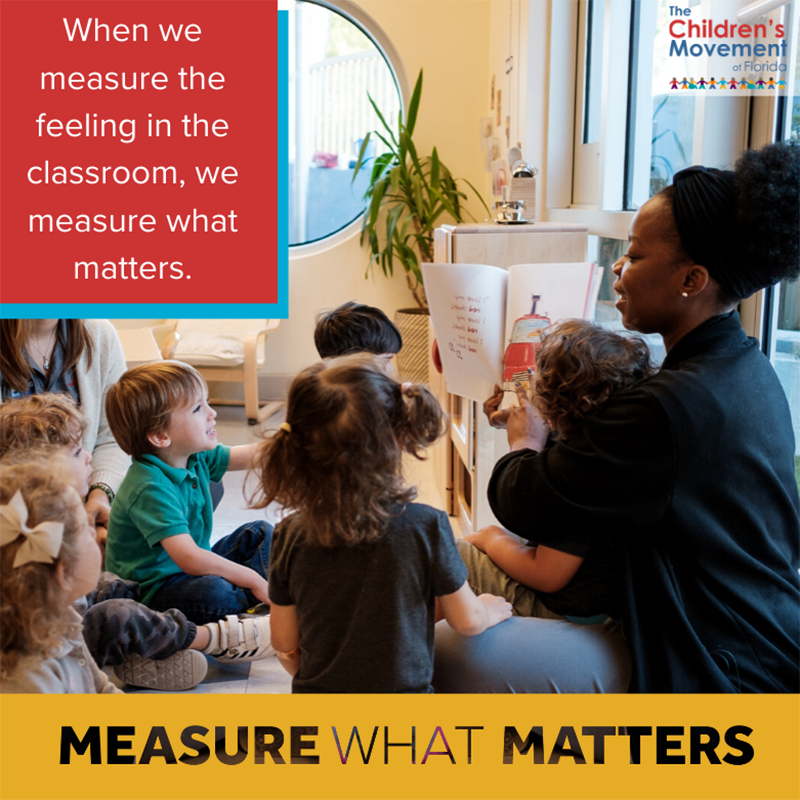
When we measure the feeling in the classroom, we measure what matters.
It’s difficult to manage children if you don’t have a relationship with them. That’s why it’s important to measure the feeling in a classroom. Early learning centers are motivated to achieve what they are measured by. If we prioritize the relationship between teachers and students, we will create better learning environments #ForFloridaChildren.
When we measure positive classroom environment, we see:
- Teachers and students have positive relationships and enjoy each other (they are not irritated with each other).
- Children are excited to learn and be in the class (negative situations are deescalated and diffused by teacher).
- Teachers and students are respectful of one another (No bullying, threatening).
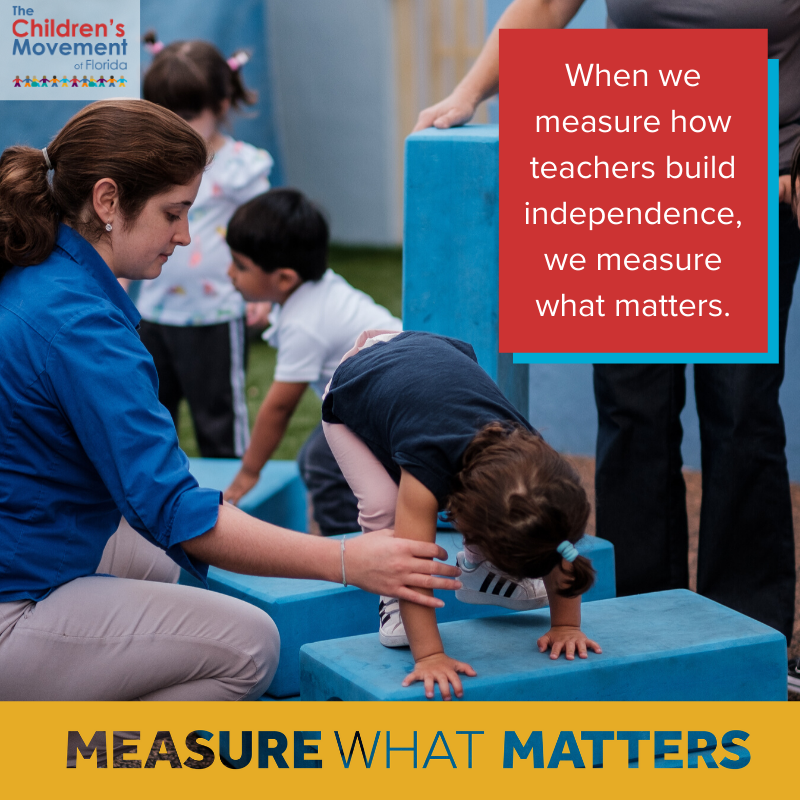
When we measure how teachers build independence, we measure what matters.
It’s difficult to manage children if you don’t have a relationship with them. That’s why it’s important to measure how teachers build independence in their students. Early learning centers are motivated to achieve what they are measured by. If we prioritize a teacher’s ability to inspire independence, we will create better learning environments #ForFloridaChildren.
When we measure how a teacher builds student independence, we see:
- Teachers are flexible in incorporating children’s interests and ideas in their learning activities
- Teachers encourage children to express their ideas
- Teachers foster independence and responsibility in children
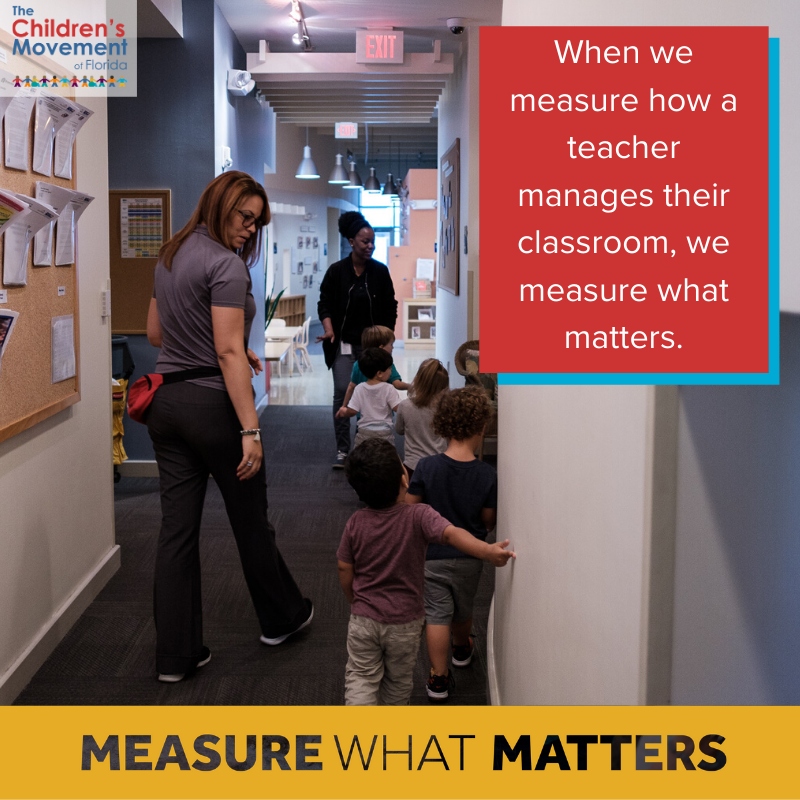
When we measure how a teacher manages their classroom, we measure what matters.
It’s difficult to ask children to learn if their work environment is chaotic. That’s why it’s important to measure how teachers manage behavior their classrooms. Early learning centers are motivated to achieve what they are measured by. If we prioritize a teacher’s ability to manage behavior, we will create better learning environments #ForFloridaChildren.
When we measure how a teacher manages behavior, we see:
- Clear rules and expectations consistently reinforced
- Teachers are proactive in anticipating difficulty
- Teachers reinforce positive behaviors and redirect unwanted ones
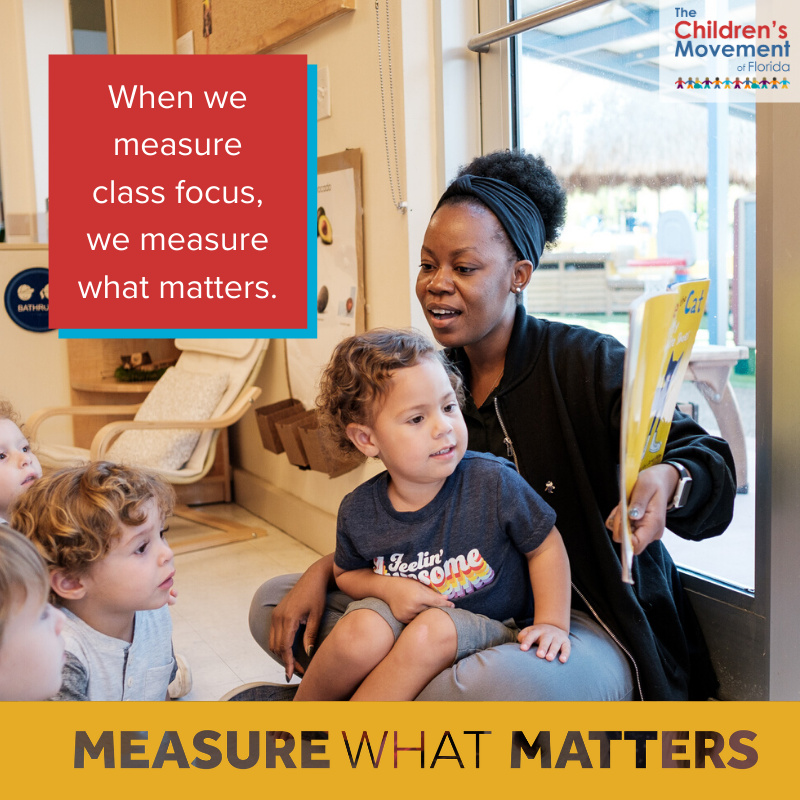
When we measure class focus, we measure what matters.
It’s difficult to ask children to learn if their work environment is chaotic. That’s why it’s important to measure how teachers build productive classrooms. Early learning centers are motivated to achieve what they are measured by. If we prioritize a focused classroom, we will create better learning environments #ForFloridaChildren.
When we measure how focused a classroom is, we see:
- Teachers maximize learning time by having clearly defined learning activities ready for children so transitions are brief, little waiting, few disruptions
- Routines children know and follow throughout the day
- Little wandering in the productive classroom

When we measure class engagement, we measure what matters.
It’s difficult to ask children to learn if their work environment is chaotic. That’s why it’s important to measure how teachers keep students engaged. Early learning centers are motivated to achieve what they are measured by. If we prioritize an engaged classroom, we will create better learning environments #ForFloridaChildren.
When we measure how engaging a teacher is, we see:
- Teachers actively facilitate children’s involvement in activities
- They use a variety of materials and modalities to teach
- Children are focused and actively involved in lessons
- Learning objectives are clear.
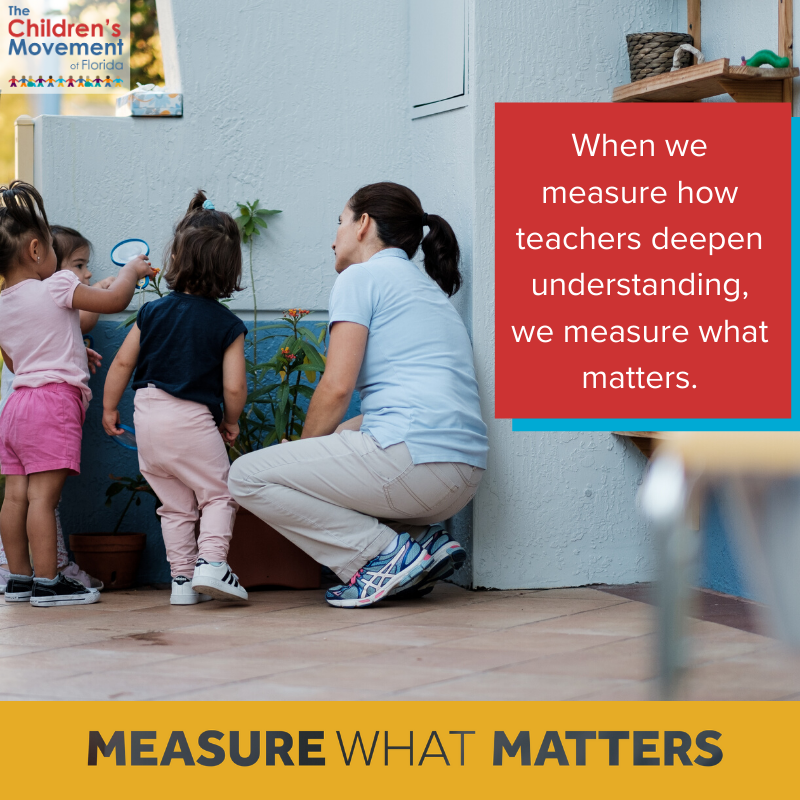
When we measure how teachers deepen understanding, we measure what matters.
Early learning teachers have the opportunity to mold how children learn for the rest of their lives–but we can’t expect students to think critically if they aren’t challenged by a sensitive teacher in a structured classroom.
That’s why it’s important to measure how teachers deepen student understanding. Early learning centers are motivated to achieve what they are measured by. If we prioritize a teacher’s ability to deepen student’s knowledge, we will create better learning environments #ForFloridaChildren.
When we measure how a teacher deepens student knowledge, we see:
- Teachers intentionally sustain interactions that deepen and expand understanding
- Ask ‘Why’ and ‘how’ questions to encourage analysis and reasoning
- Integrate new ideas into previous knowledge and connect it with real-world applications
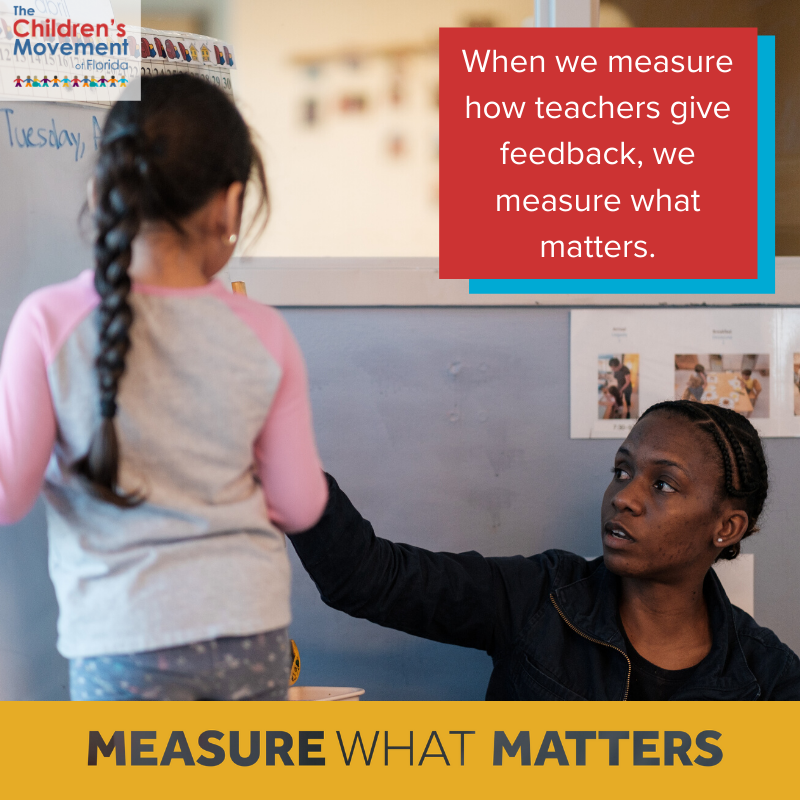
When we measure how teachers give feedback, we measure what matters.
Early learning teachers have the opportunity to mold how children learn for the rest of their lives–but we can’t expect students to think critically if they aren’t challenged by a sensitive teacher in a structured classroom.
That’s why it’s important to measure how teachers give feedback. Early learning centers are motivated to achieve what they are measured by. If we prioritize a teacher’s ability to give quality feedback we will create better learning environments #ForFloridaChildren.
When we measure how a teacher gives quality feedback, we see:
- They focus on the process of learning rather than getting the ‘right answer’
- They provide children with specific information about their work by expanding and clarifying ideas
- They ask follow-up questions to help deepen understanding
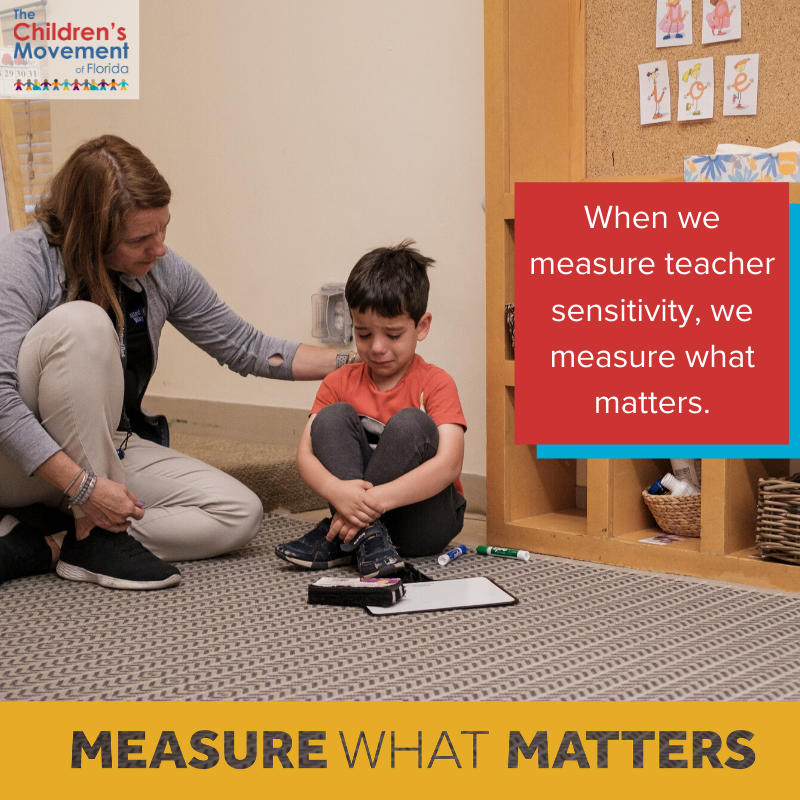
When we measure teacher sensitivity, we measure what matters.
It’s difficult to manage children if you don’t have a relationship with them. That’s why it’s important to measure teacher sensitivity in a classroom. Early learning centers are motivated to achieve what they are measured by. If we prioritize a teacher’s knowledge of her students, we will create better learning environments #ForFloridaChildren.
When we measure teacher sensitivity, we see:
- Teacher knows students well enough both academically and socially to be aware of and respond to their needs. This includes treating each child as an individual when it is time to challenge, motivate, or redirect them.
- Children are comfortable to freely participate and take risks, seeking adult support and guidance when needed.
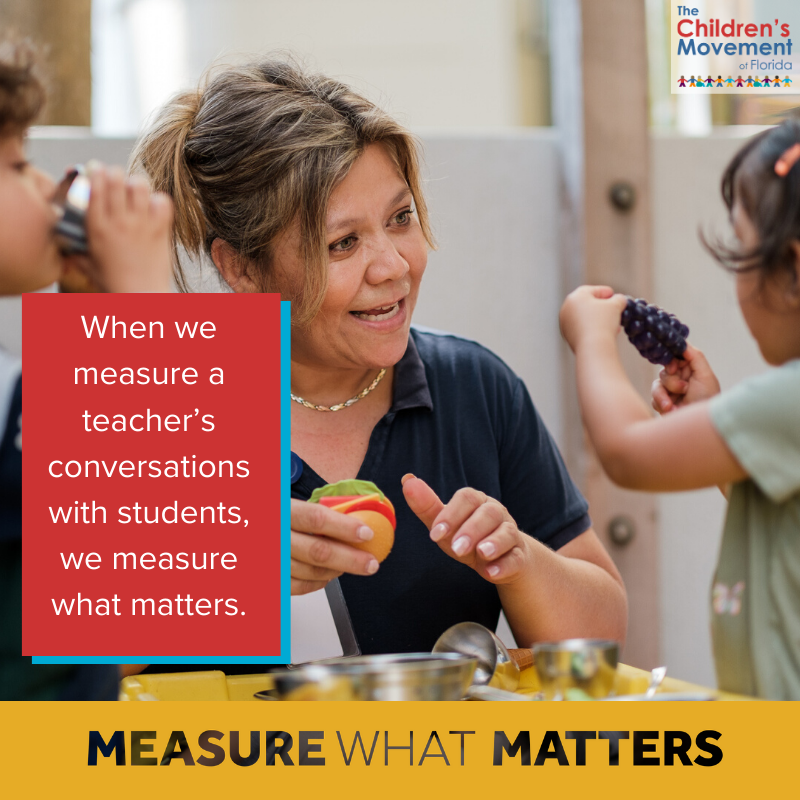
When we measure a teacher's conversations with students, we measure what matters.
Early learning teachers have the opportunity to mold how children learn for the rest of their lives–but we can’t expect students to think critically if they aren’t challenged by a sensitive teacher in a structured classroom.
That’s why it’s important to measure how often teachers engage students in conversation. Early learning centers are motivated to achieve what they are measured by. If we prioritize a teacher’s conversations with students, we will create better learning environments #ForFloridaChildren.
When we measure a teacher’s conversations with students, we see:
- Teachers participate in frequent conversations
- Teachers ask open-ended questions
- Teachers repeat, extend, and elaborate children’s responses
- Teachers use advanced language that contains a variety of words.
Support our Early Ed Teachers
This fall we are running a campaign to share the harsh realities faced by our early learning educators. This comes out of one of our 2020 Agenda priorities: Celebrate and Support Educators.
Early learning educators are integral to the development of the next generation. Science tells us that the most important way young children learn is through a strong bond with their caregivers. When parents have to work, early learning educators help with this important job.
When our early learning educators are stressed, struggling to pay their families’ bills, and worrying about being able to feed their families, they can’t bring everything our children need to school. We need to put our teachers first to put our children first.
This campaign is a partnership with The Children’s Trust of Miami-Dade’s Thrive by Five program and the UC Berkeley Center for the Study of Child Care Employment (CSCCE). The statistics are taken from CSCCE’s 2018 SEQUAL Study in Miami-Dade.
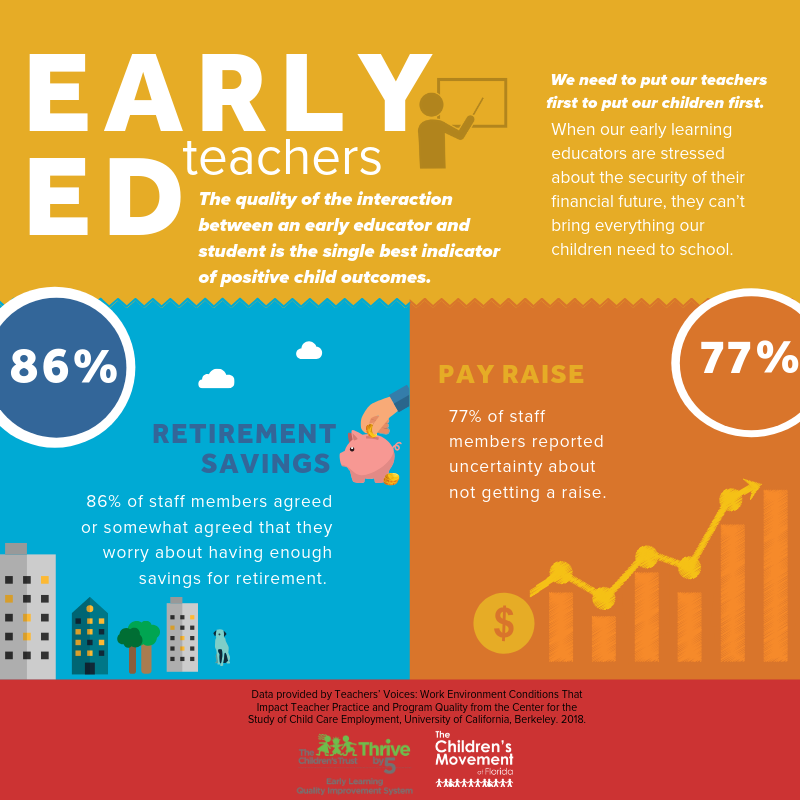
When our early learning educators are stressed about the security of their financial future, they can't bring everything our children need to school.

When our early learning educators are worrying about having their hours reduced, being laid off, or being sent home without pay, they can't bring everything our children need to school.
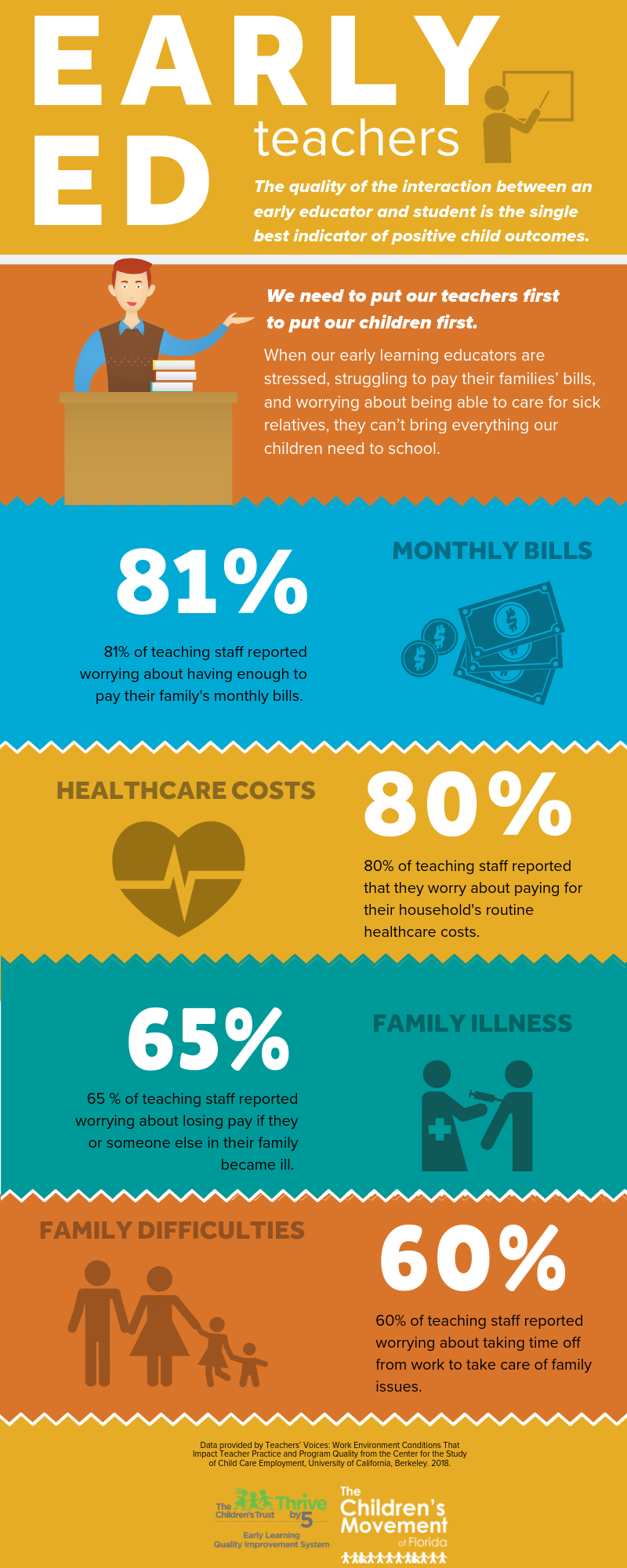
When our early learning educators are stressed, struggling to their families bills, and worrying about being able to take care of sick relatives, they can't bring everything our children need to school.

When our early learning educators are stressed and struggling to pay for basic living expenses and housing, they can't bring everything our children need to school.
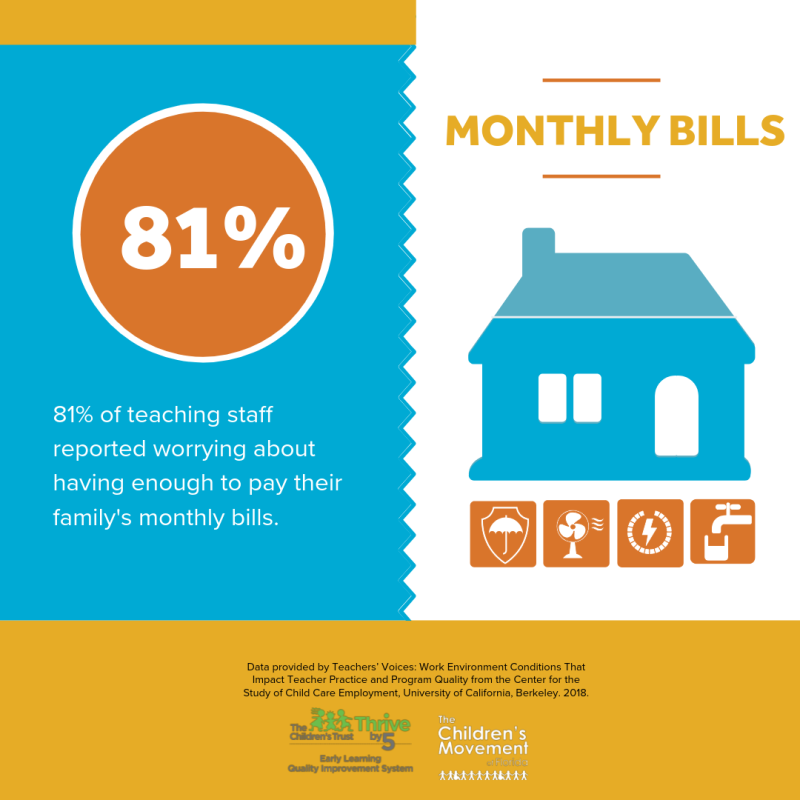
81% of teaching staff worried about having enough to pay their family's monthly bills.
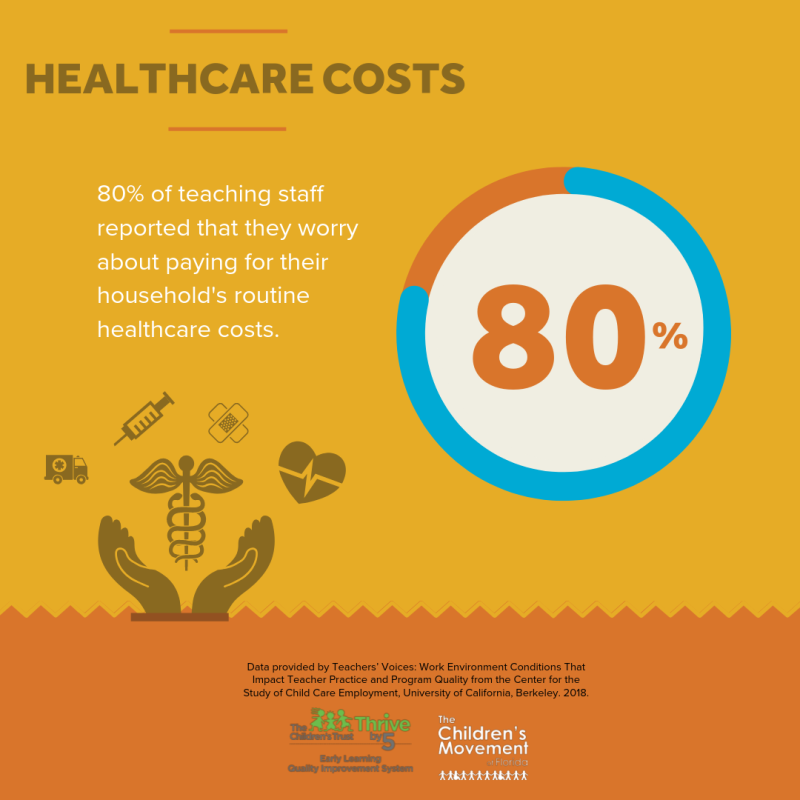
80% of teaching staff reported that they worry about paying for their household's routine healthcare costs.
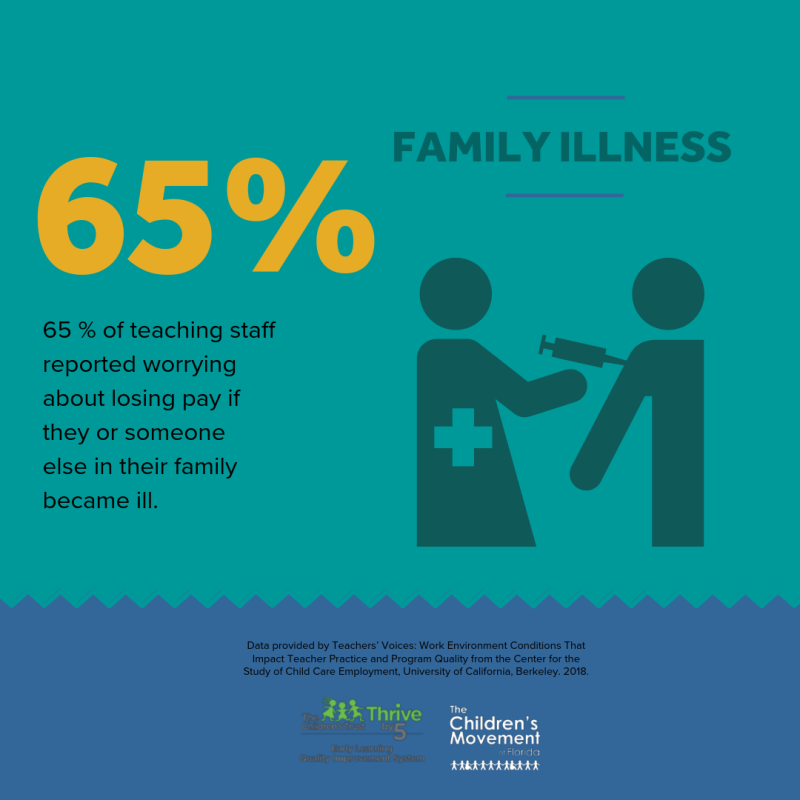
65% of teaching staff reported worrying about losing pay if they or someone else in their family became ill.

60% of teaching staff reported worrying about taking time off from work to take care of family issues.
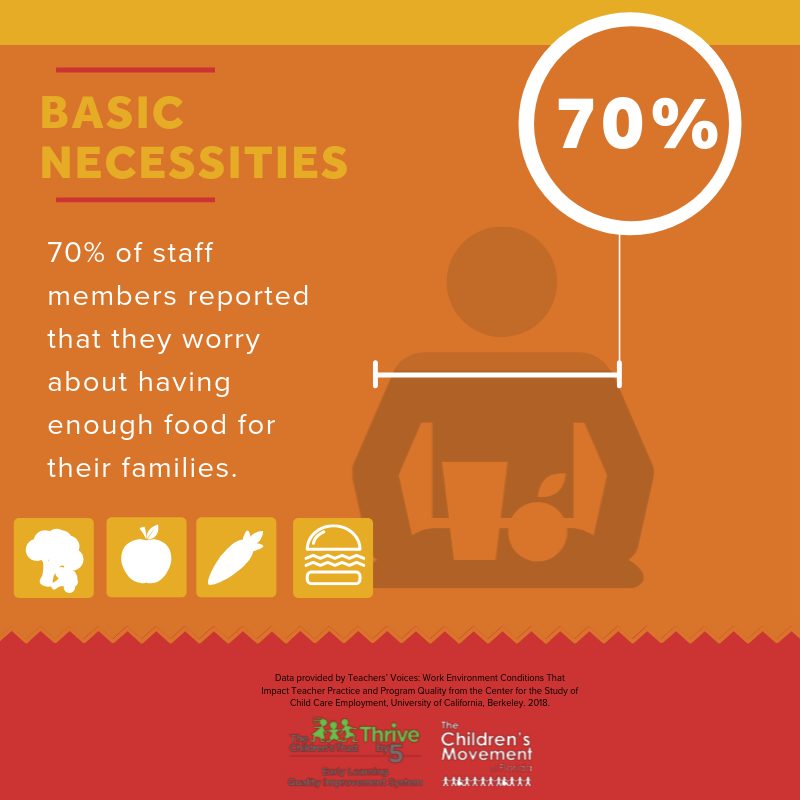
70% of staff members reported that they worry about having enough food for their families.
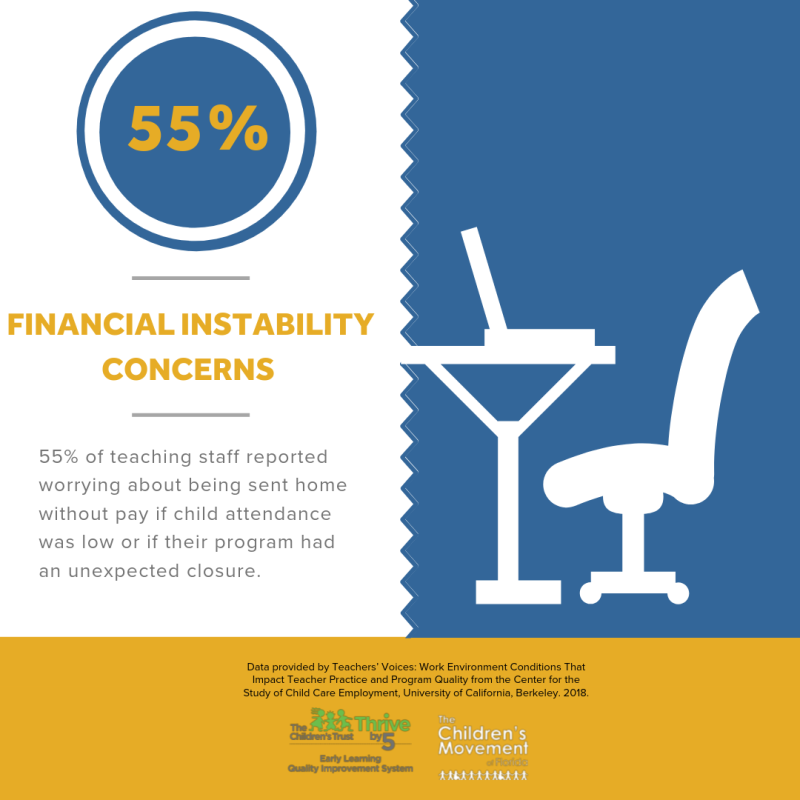
55% of teaching staff reported worrying about being sent home without pay if child attendance was low or if their program had an unexpected closure.
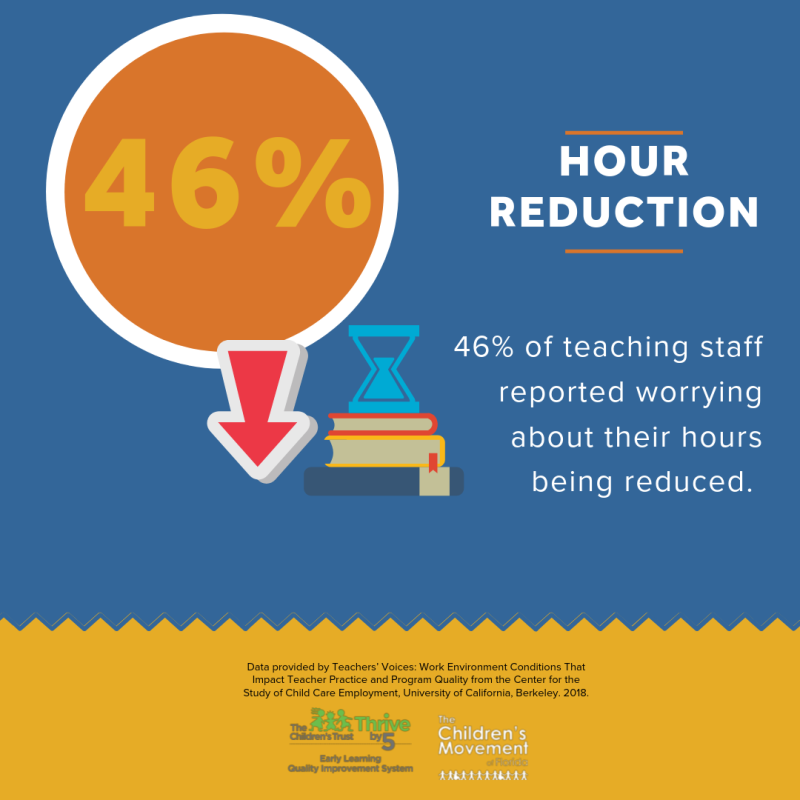
46% of teaching staff reported worrying about their hours being reduced.
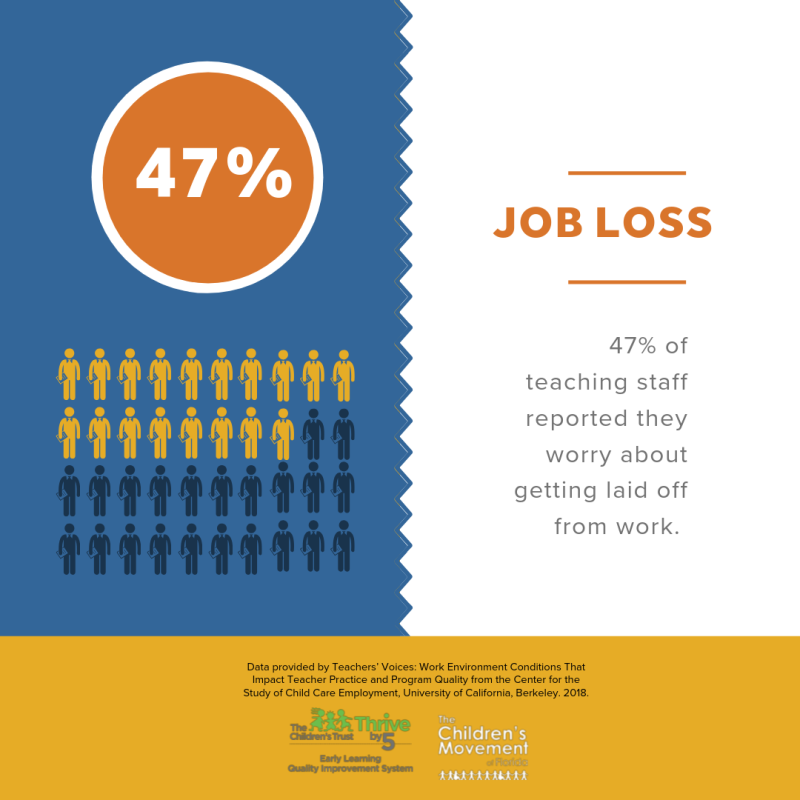
47% of teaching staff reported they worry about getting laid off from work.
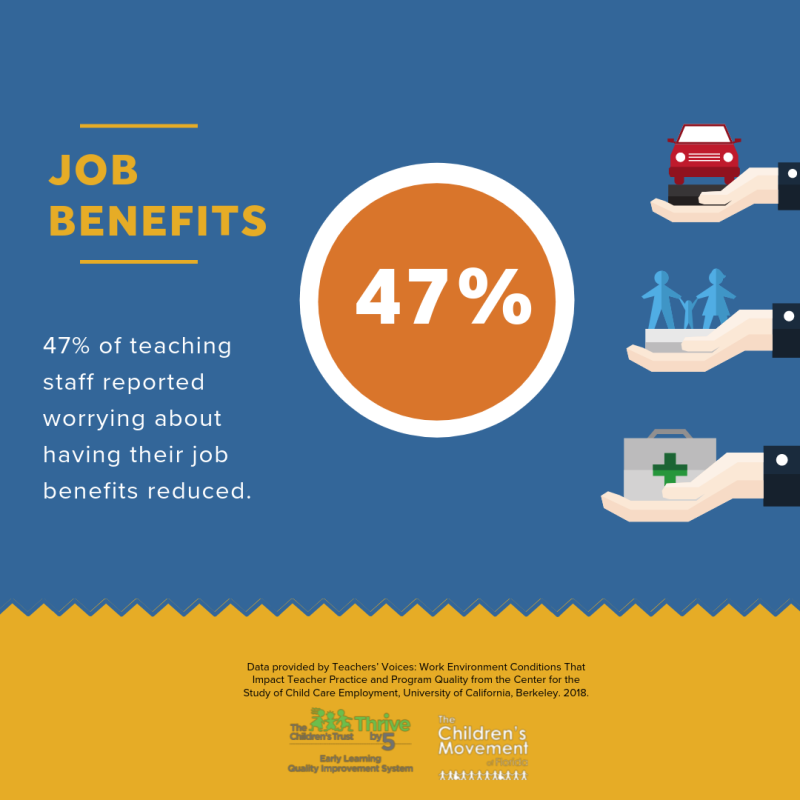
47% of teaching staff reported worrying about having their job benefits reduced.
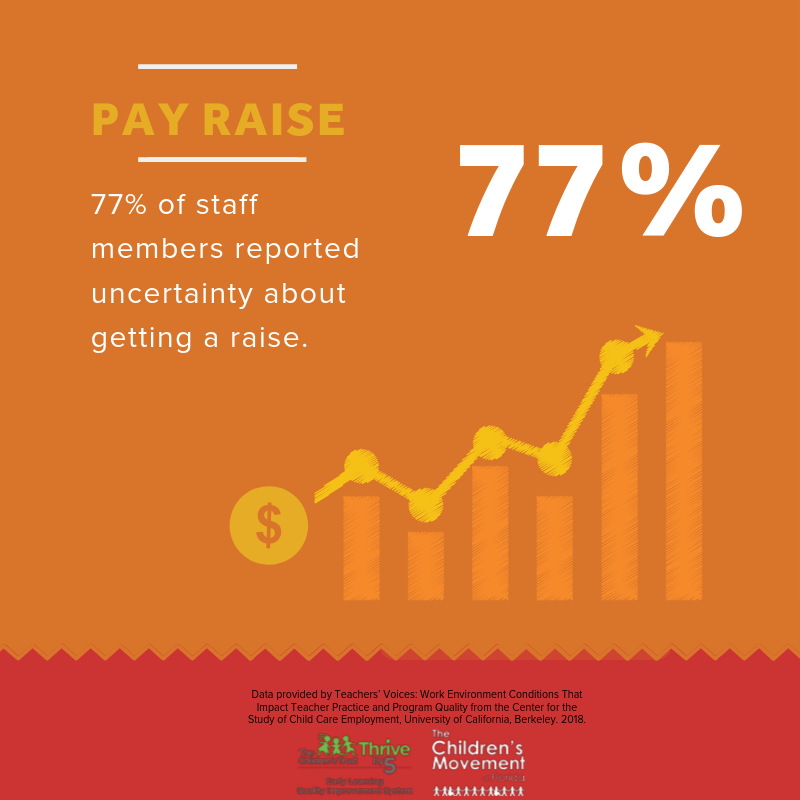
77% of staff members reported uncertainty about getting a raise.
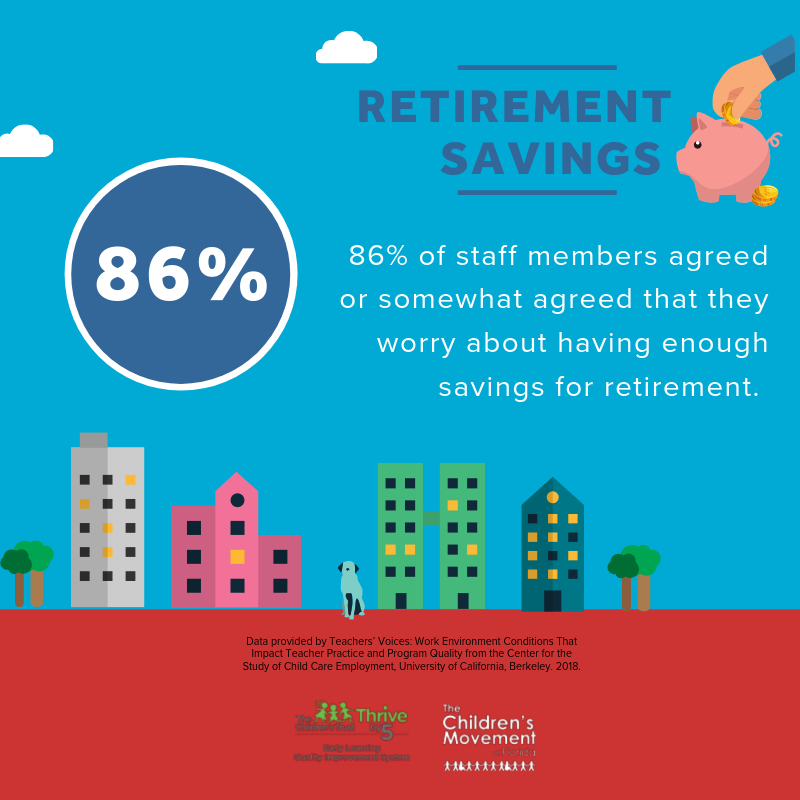
86% of staff members agreed or somewhat agreed that they worry about having enough savings for retirement.
